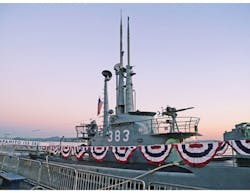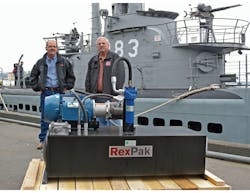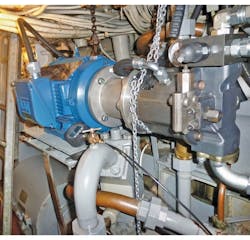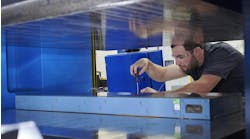A popular attraction at San Francisco’s historic Fisherman’s Wharf is its World War II submarine, the USS Pampanito. More than 110,000 people visit the Pampanito annually, a Balao-class submarine which had six combat patrols in the Pacific War and is now a U.S. National Historic Landmark. Operated by the non-profit San Francisco Maritime National Park Assn., the Pampanito has been restored by association volunteers to a specific point in time, late 1945, to represent the height of WWII submarine development. This restoration effort includes making key submarine systems fully functional, so visitors can see the periscope raised and lowered and torpedo doors opened and closed. To accomplish this goal, the Pampanito needs efficiently functioning hydraulics — and Bosch Rexroth, Charlotte, N.C., contributed a custom-configured RexPak hydraulic power unit (HPU) to help bring the boat’s hydraulics back to life.
This file type includes high resolution graphics and schematics when applicable.
Working Memorial to the Pacific War
Since the association took possession of the boat in 1976, it has undergone multiple restoration projects — including four separate dry-dock visits. Almost all of the boat’s systems have been restored; as a result, much of its on-board electrical and mechanical equipment is now functional. “As much as possible, we try to utilize 1940s era technology for the restorations,” said Richard Pekelney, secretary on the association’s board of trustees. “However, for some systems, we find it’s more effective for us to incorporate modern equipment.
Three of the sub’s hydraulic systems have been restored to working condition: the external bow planes used in navigating the ship; the torpedo tube doors; and the ship’s periscope. Until recently, hydraulic power was supplied to this equipment by the boat’s original air-over-hydraulic power unit. This HPU pumped high-pressure air into a hydropneumatic accumulator to transmit the hydraulic flow and pressure necessary to operate the equipment.
However, the air-over-hydraulic system presented some limitations. It took up to a full day to get the high-pressure air system running. Furthermore, safety considerations required proper training for its operation, which usually required the assistance of a naval veteran with background in operating pneumatic and hydraulic systems. Volunteers provide virtually all the restoration, maintenance, and operation work performed on the Pampanito, so keeping the pneumatic-hydraulic system running was problematic, limiting the times it could be operated. A former Navy submariner who volunteers on the sub decided to find a better, simpler solution. All it took was a hand-drawn sketch on a piece of paper.
One Volunteer’s Passion for the Pampanito
Charlie Butcher is Equipment Manager for Northern California at Manson Construction Co., Seattle, one of the nation’s leading heavy civil marine construction and dredging companies. He’s also a retired U.S. Navy Master Chief Petty Officer and submariner with 30 years of service in the U.S. Navy and Navy Reserves. Manson Construction has long supported the restoration and historic operation activities of the Pampanito as a museum boat by taking care of moorings and other maintenance.
“Initially, I wanted to find a simple pressure-compensated hydraulic pump to raise the periscope,” said Butcher. In discussions with Pekelney, it became clear that being able to open the torpedo tube doors and move the boat’s bow planes, (which would make it easier to perform hull maintenance when the submarine goes into dry-dock) were priorities as well.
A New HPU
As Butcher and Pekelney refined their hydraulics requirements, Butcher contacted Bill McDaniel, account manager at Hydraulic Controls, Inc., Emeryville, Calif. Hydraulic Controls is a leading supplier of hydraulic components in the Pacific Southwest and a Bosch Rexroth distributor. That’s where the sketch comes in. “We knew we would need a larger solution than just a simple pump,” Butcher said. “I knew the boat’s hydraulic systems, so I made a little design sketch and sent it to everybody to see what we could work out.”
According to McDaniel, Butcher’s sketch and descriptions of the boat’s hydraulics requirements led him to consider several options. ”At first, we looked at using a closed-coupled motor package,” he said. “But after consulting with Rexroth, we decided that the RexPak hydraulic unit was a better option. We could supply a complete package, test it, make sure everything was good to go, and ship them the whole system.”
The RexPak hydraulic power unit bridges the gap between standard products and custom-engineered power units. Designed for a variety of applications that require hydraulic power up to 75 hp, with flow to 65 gpm, and operating pressure to 3,200 psi, each RexPak system is custom-configured from a core set of components: motor, pump, reservoir, and associated control valves. Although each RexPak solution is unique, units are built from readily available Rexroth hydraulics products and can be designed, configured and delivered in as little as six weeks.
HPU Offers the Right Fit
McDaniel worked with Bosch Rexroth to create the Pampanito’s RexPak configuration. They used the RexPak Design Engine, an online configuration tool that captures key data needed to configure a RexPak hydraulic power unit. “It was extremely helpful in guiding us to determine the right configuration to provide the hydraulic pressure required to operate the boat’s equipment,” McDaniel offered. “It gave us all the right questions to ask — the weight of the bow planes and periscope, how much hydraulic fluid is accumulated from the forward engine room, distances from the HPU to where the equipment it will operate, and so forth.”
The RexPak for Pampanito is configured with a 71-cc Rexroth A10VSO axial-piston pump driven by a 15 hp motor. It provides flow of 30 gpm at a maximum working pressure of 750 psi. It includes an 80-gal reservoir, an inline-mounted relief valve, pressure gauge, and return and pressure filters. According to Butcher, this configuration provides sufficient hydraulic power to demonstrate how the different pieces of equipment on the boat work. For example, raises and lowers the 2,000-lb periscope at its original speed.
Each piece of equipment operates independently, so the RexPak does not have to supply hydraulic power to all three systems simultaneously. And because the RexPak has been integrated into the boat’s existing hydraulic lines, the boat’s original controls on the bridge and in the engine and torpedo rooms operate as originally designed. McDaniel explained that the RexPak Design Engine system also helps Butcher and his fellow volunteers with detailed documentation. “It provides an engineered drawing and a detailed datasheet of every component, so we could take the original sketch and make it into something formal in a very short period of time.”
Donations Support Restoration
Butcher believed the RexPak unit would work well in the Pampanito, due to its modularity and ease of integration with the boat’s existing hydraulics piping and controls — even though much of that equipment is decades old. The team installed the Rexroth equipment in such a way that modern technology operates the boat’s original hydraulics plant to retain the museum ship’s authenticity. “We wanted to keep the functionality of the original system,” he said. “We had to install some special flanges and mounting brackets in some places, but in most cases you can’t even tell that the system’s there.” Technicians were able to fabricate brackets to take advantage of existing bolts and holes to support the RexPak pump, motor controller, hydraulic fluid filters, and other system elements.
This file type includes high resolution graphics and schematics when applicable.
Using the RexPak unit also will help the Pampanito save energy because it takes much less power than the high-pressure air compressor did. Plus, the modular system can be easily broken down into its constituent parts, carried piece-by-piece other areas decks, then reassembled. According to Butcher, this helped simplify installation. The RexPak unit is also much easier to operate, which means many more volunteers, not just veterans, can be trained on it, so the periscope and other systems can be demonstrated more frequently to visitors eager to see the authentic WWII submarine.
The valuable time and effort to get the right solution for the Pampanito’s hydraulic restoration was all donated — as was the RexPak unit itself: Bosch Rexroth provided the system at cost to Hydraulic Controls Inc., who donated the complete system and their time. And, of course, Charlie Butcher and other Manson Construction Co. technicians have been donating time to configure brackets and other supporting materials to complete the project.
The 30-year Navy man and former submariner appreciates how the RexPak HPU makes some of the more popular Pampanito sub equipment operational. “Everyone wants to look out the periscope,” said Butcher. ”From the young people to the World War II submarine vets and their wives, they all like to see things in operation, so we know the visitors will really appreciate it.”
Joseph Kane is Regional Sales Manager for Machinery Applications and Engineering, Bosch Rexroth Corp., Charlotte, N. C. For more information, visit boschrexroth-us.com.





